Jack
[Donkey Type] A jack is a male donkey.
Jack Boots
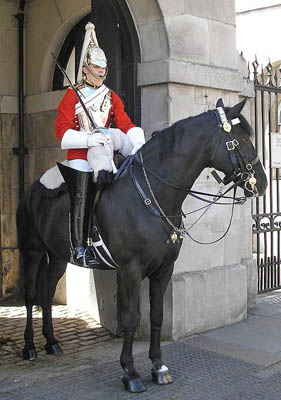
|
[Military Equipage] A Jack Boot is a long high topped dress boot with a flare and open area in the rear top. Believe it or not these receive 200 hours of polishing prior to a royal birthday review. They date from the 18th century but are still part of the dress of the British Household Cavalry Regiments.
Jack Pot
[Funding Method] A jack pot is a sum of money paid by an entrant to a horse show or rodeo that funds the prize given to the winner.
Jennet
[Horse Breed] A Jennet is traditional small, ambling, Spanish riding horse. Jennets were more a type than established breed and in their original form are no longer existent, having passed from fashion. The ability to amble is genetic and Jennets may have contributed to modern gaited South American breeds. There are now what are called Spanish Jennet Horses that mirror the characteristics of the original Jennet type and are more closely regulated as a true breed.
Jenny
[Donkey type] A Jenny is a female donkey.
Jibbah
[Arabian Anatomical Feature] The jibbah is a slight forehead bulge between the eyes that is one of the characteristic features of the Arabian horse. It was believed by Bedouins to be a sign of intelligence and selectively bred for.
Jig (Jigging or Jogging)
[Equine Gait] A jig is a type of fast, short, tense, jerky, choppy trot that a horse may do when it is excited or has not been exercised for a long time. The same horse may be able to offer a totally normal trot under other circumstances. Needless to say, once experienced, they add yet another chapter to the term pleasure ride. They are nearly impossible to sit to or even to post to. Often the horse is simultaneously fighting with the bit and difficult to halt. It is no fun riding in a two point all day. The term jig trot is understood as a slightly different gait.
Jig Trot
[Equine Gait] For English riders a jig trot is very similar to a jig, but is a pronounced version with a more exaggerated bouncing motion. If the horse can be caused to slow down and remain in suspension longer it would not be so bad.
Jimsonweed (Datura stramonium)
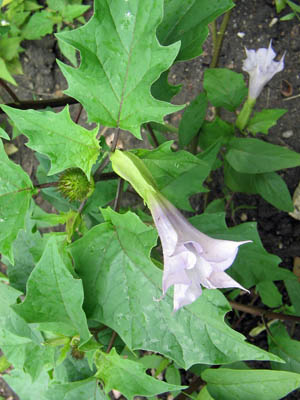
|
[Toxic Plant to Horses] Jimsonweed is a tall toxic shrub with hanging, trumpet-shaped flowers that horses generally will avoid eating. However, it can be mixed with hay in a dry form and poisoning might occur. The toxins are tropane alkaloids: atropine, hyoscyamine, and scopolamine. The effects are hyperthermia, tachycardia, bizarre behavior, urinary retention, and painful photophobia. Physostigmine is an antidote.
Jockey Club
[Equestrian Organization] There are organizations by the name of the Jockey Club in several nations. The original English Jockey Club was formed in 1750 and was an organizing and regulating body for both horse racing and the Thoroughbred horse breed. A similar organization was established in the United States in 1893 and maintains the registry of Thoroughbred horses.
Jodhpurs
[Riding Apparel] Jodhpurs are riding breeches that are cut full through the hips and close-fitting from knee to ankle. They often are reinforced by leather patches in the inside of the thighs and the knees and they are designed to the worn with boots. Common blue jeans often have seams that rub the legs during horseback riding but jodhpurs are specifically made for riding and more comfortable. True jodhurs were common in years past, but more modern breeches are cut more narrowly through the hips.
Johnson grass (Sorghum halepense)
[Toxic Plant to Horses] Johnson grass is a toxic invasive species of grass that when wilted and eaten in quantity contains sufficient amounts of hydrogen cyanide to kill a horse.
Jog
[Equine Gait] In western riding a jog is a slow collected trot to which the rider sits in the saddle.
Jointed Eggbutt Snaffle Bit

|
[Equine Equipage] A jointed eggbutt snaffle bit is a non-leverage bit with a hinged mouthpiece and a joint in the egg shaped ring. The ring is designed not to pinch the horses mouth. It is considered a mild bit.
Jointed Full Cheek Snaffle Bit
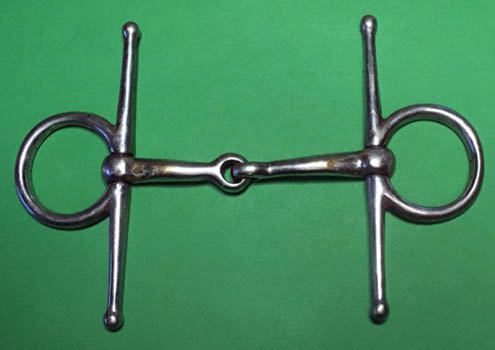
|
[Equine Equipage] A jointed full cheek snaffle bit is a non-leverage bit with a hinged mouthpiece and a joint in a Fixed round ring with bars extending both sides top and bottom. The ring is designed not to pinch the horses mouth and the bars to aid in steering.
Jousting
[Equestrian Sport] Traditional jousting was a martial sport between two armored horsemen using lances with blunted tips, often as part of a tournament. It was extremely popular during the middle ages but fell out of fashion with the decline of the mounted knight. Jousting was a dangerous, occasionally fatal, sport. French King Henry II, of Valois died in 1559 of injuries sustained while jousting. Today, jousts are reenacted as a part of Renaissance pageants. What struck me as I watched them was just how "into it" the horses were. They very much seemed to enjoy rushing the opponent. In a different modern form of jousting, a lone rider uses a lance to spear a small suspended ring that is 6 to 8 feet off the ground. In 1962 the state of Maryland was the first state to have an official sport when it designated this form of jousting as the sport.
Judge
[Showing] The judge is an individual who is tasked with evaluating and ranking the competitors, both human and equine in horse shows. Typically, a ribbon or trophy is given to the competitors as a result of the judge's decision. Judges tend to be specialized in competitions that they themselves undertook with distinction earlier in their career. A good judge should have deep understanding of the breed standards, good observation skills, and the ability to fairly evaluate each competitor based on performance, exhibiting professionalism and impartiality. Many judges will voice a critique of the rider's performance with an eye to how the rider might improve at the end of the class. Judges themselves complete an apprenticeship with a mentor, advance to being a recorded judge and finally are recognized as registered judge. They will advertise their availably to act a a judge in equestrian publications. Their average fee at this time for a rated show is $500. I have often felt that we should have curated shows in which the judges are in turn judged by other judges. It would only be fair. "Judge not, that ye be not judged" (Mathew 7:1), right.
Judged Trail Ride (Judged Pleasure Ride)
[Equestrian Competition] Judged Trail Rides are a type of competitive trail riding on a natural trail for a set distance, typically 10 to 15 miles. There is no time pressure, but the riders stop at stations set along the course at which the judges ask them to demonstrate trail riding skills. For example, to mount from the right side, jump a ditch, put on a rain slicker while mounted, ride over a sheet of dark plastic, etc. Rides are informal, often sponsored by riding clues, and rules variable.
Jumping Ahead of the Horse
[Jumping] Jumping ahead of the horse happens when a rider's timing is off. The rider forces himself too far forward over the horse's front end at the beginning of the jump rather than wait for the horse's momentum to bring him forward in the correct position. With correct timing the rider will maintain a balanced position over the horse's center of gravity and be much less likely to fall off. When I was learning, I frequently jumped ahead of the horse. When you jump there are so many body parts that you need to correctly position within a matter of seconds. Once you get it and practice many times muscle memory takes over and you no longer need to work so hard at your timing.
Jump Off
[Jumping Competition] A jump off occurs when an extra show jumping round is added to break a tie.
Junior Equitation League (JEL)
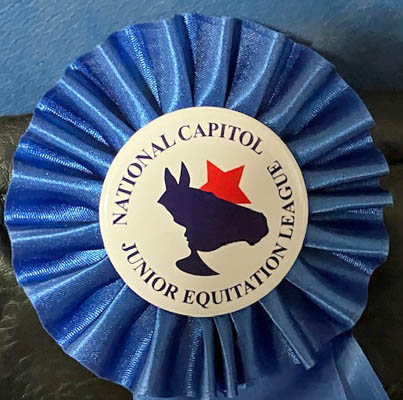
| 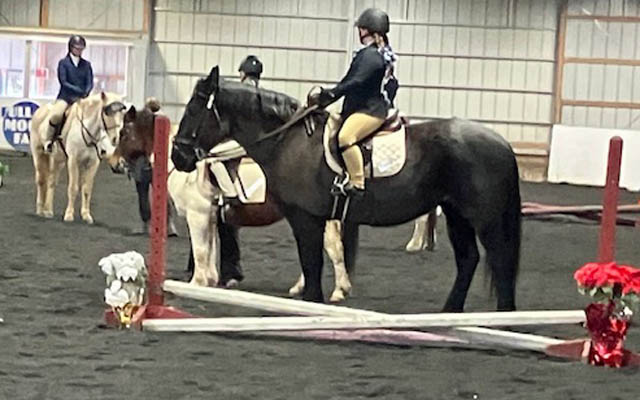
|
[Equestrian Organization] The Junior Equitation League is a organization that promotes the art of equitation. They sponsor horse shows for young equitation riders.